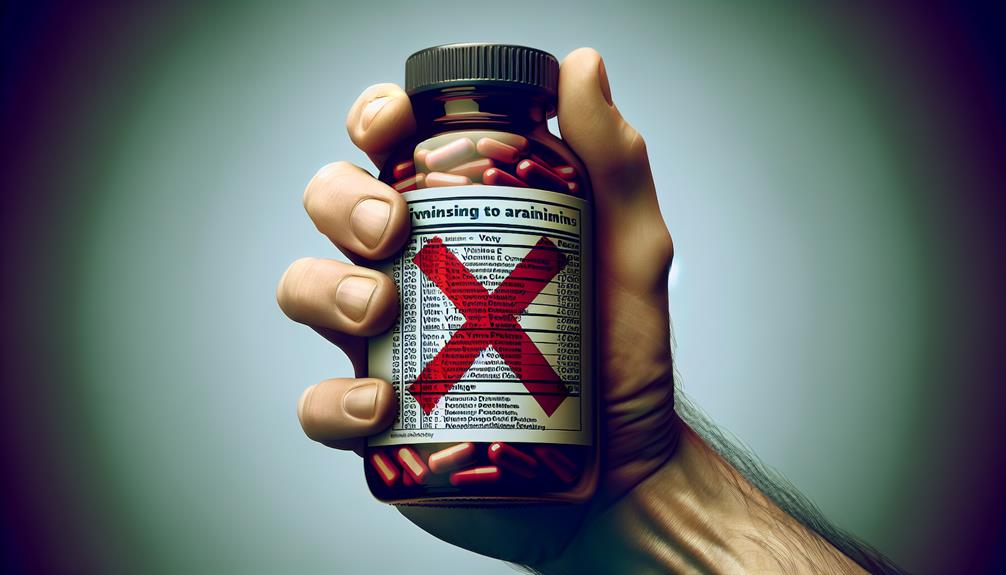
Monitor your blood glucose levels efficiently to manage diabetes effectively, gain insights into your body's responses, and make informed lifestyle decisions. Utilize devices like glucometers for on-the-go testing or continuous glucose monitoring systems for real-time data. Interpret readings carefully, noting patterns and influencing factors beyond food and medication. Set personalized target levels with your healthcare provider to reduce diabetes complications. Manage stress, maintain accuracy in testing, and adjust lifestyle factors for stable glucose levels. Explore tips for accurate monitoring, managing high and low levels, all essential for a healthier life.
Key Takeaways
- Regular blood glucose monitoring is essential for diabetes management.
- Glucometers provide portable, quick readings for on-the-go monitoring.
- Continuous Glucose Monitoring (CGM) systems offer real-time insights and trend analysis.
- Understanding factors like diet, exercise, and stress impact blood glucose levels.
- Target personalized blood glucose levels with healthcare provider for effective management.
Importance of Blood Glucose Monitoring
Blood glucose monitoring plays a crucial role in managing diabetes by providing valuable insight into your blood sugar levels throughout the day. By regularly checking your blood glucose levels, you can track how your body responds to food, exercise, medication, and other factors. This information allows you to make informed decisions about your lifestyle and treatment plan.
Monitoring your blood glucose levels helps you understand the impact of different foods on your body. By identifying how certain foods affect your blood sugar, you can make dietary choices that help keep your levels within a healthy range. Additionally, tracking your blood glucose levels before and after exercise can show you how physical activity influences your body's insulin sensitivity.
Consistent monitoring also enables you to detect and address fluctuations in your blood sugar levels promptly. By staying proactive, you can prevent hyperglycemia (high blood sugar) or hypoglycemia (low blood sugar) episodes, reducing the risk of complications associated with poorly controlled diabetes.
Types of Glucose Monitoring Devices
Various advanced technologies have been developed to assist individuals in monitoring their glucose levels accurately and conveniently. One common type of glucose monitoring device is the glucometer, which measures blood glucose levels from a small drop of blood obtained by pricking the skin. These devices provide quick results and are portable for on-the-go monitoring.
Another type is the continuous glucose monitoring (CGM) system, which involves sensors placed under the skin to provide real-time glucose readings throughout the day.

Some devices also offer connectivity features, allowing data to be shared with healthcare providers for remote monitoring and analysis. Additionally, there are non-invasive glucose monitoring devices that use technologies like optical sensors to measure glucose levels without the need for skin pricks.
It's important to choose a monitoring device that suits your lifestyle and monitoring needs, ensuring accurate and reliable results to effectively manage your blood glucose levels.
Continuous Glucose Monitoring (CGM)
Utilizing cutting-edge sensor technology, Continuous Glucose Monitoring (CGM) systems offer individuals real-time insights into their glucose levels throughout the day. These devices provide a continuous stream of data, revolutionizing the way people manage their diabetes.
Here are three key aspects of CGM systems:
- Continuous Monitoring: CGM systems measure glucose levels in interstitial fluid, providing a more comprehensive picture of glucose fluctuations compared to traditional fingerstick tests. This continuous monitoring helps individuals understand their glucose patterns beyond isolated readings.
- Alerts and Alarms: CGM devices can alert users to hypo- or hyperglycemic events in real-time, allowing for prompt intervention. These alerts are customizable based on individual preferences and thresholds, enhancing safety and peace of mind.
- Trend Analysis: CGM systems offer detailed data on glucose trends over time, enabling users to identify patterns, triggers, and the effects of lifestyle choices on their glucose levels. This analytical feature empowers individuals to make informed decisions to better manage their condition.
Self-Monitoring Blood Glucose (SMBG)
For individuals managing diabetes, monitoring your blood glucose levels through Self-Monitoring Blood Glucose (SMBG) is a fundamental aspect of daily care and treatment. SMBG involves using a glucometer to measure your blood sugar levels at various times throughout the day, such as before and after meals, before bedtime, or during physical activity. This allows you to track how your body responds to different foods, activities, medications, and stressors. By regularly checking your blood glucose levels, you can make informed decisions about your diet, exercise routine, and medication dosages.
SMBG also helps you identify and respond promptly to episodes of hypo- or hyperglycemia. Monitoring your blood sugar levels closely can prevent complications associated with poorly controlled diabetes, such as nerve damage, kidney disease, and vision problems. Additionally, SMBG provides valuable data that you can share with your healthcare provider to adjust your treatment plan effectively. Overall, self-monitoring blood glucose empowers you to take an active role in managing your diabetes and maintaining optimal health.

Interpreting Blood Glucose Readings
To interpret blood glucose readings effectively, understand how your body's response to food, activity, and medication impacts your levels throughout the day. Here are three key points to consider:
- Timing of Readings: Pay attention to when you're checking your blood glucose levels. Fasting levels in the morning can be different from post-meal readings. Understanding these variations can provide valuable insights into how your body processes different types of food.
- Patterns and Trends: Look for patterns in your readings over time. Tracking your levels before and after meals, as well as before bedtime, can help identify trends and make adjustments to your diet, exercise, or medication regimen accordingly.
- Factors Influencing Readings: Be aware of factors beyond food and medication that can affect your blood glucose levels, such as stress, illness, or changes in physical activity. Recognizing these influences can help you anticipate and manage fluctuations in your readings more effectively.
Target Blood Glucose Levels
Understanding the target blood glucose levels that you should aim for is essential for effectively managing your diabetes and optimizing your overall health. The target blood glucose levels vary depending on whether you have diabetes or are at risk of developing it.
For individuals with diabetes, the general target range for fasting blood sugar levels is typically between 80-130 mg/dL, while the target range for blood sugar levels before meals is around 70-130 mg/dL. Postprandial (after-meal) blood sugar levels should ideally stay below 180 mg/dL.
It's important to work closely with your healthcare provider to establish personalized target ranges based on your specific health condition, age, and other individual factors. Achieving and maintaining these target blood glucose levels can significantly reduce the risk of complications associated with diabetes, such as cardiovascular disease, nerve damage, and kidney problems.
Monitoring your blood glucose levels regularly and making necessary adjustments to your diet, exercise, and medication can help you stay within your target range and lead a healthier life.
Factors Affecting Blood Glucose
Exploring the intricate interplay between various physiological and lifestyle factors can shed light on the dynamic nature of blood glucose levels in individuals with diabetes. Understanding these factors is crucial for managing blood glucose effectively.
Here are three key factors that can significantly impact blood glucose levels:
- Diet: The type and quantity of food you consume play a vital role in determining your blood glucose levels. Carbohydrates, in particular, have a direct impact on blood sugar levels, so monitoring your carb intake is essential.
- Physical Activity: Exercise and physical activity can cause fluctuations in blood glucose levels. Regular exercise can help improve insulin sensitivity, leading to better blood glucose control. However, it's important to monitor your levels before, during, and after exercise to prevent hypo- or hyperglycemia.
- Stress: Stress triggers the release of hormones that can raise blood glucose levels. Managing stress through relaxation techniques, mindfulness, or other methods can help regulate blood glucose levels more effectively. It's crucial to find healthy ways to cope with stress to maintain stable blood glucose levels.
Tips for Accurate Monitoring
For more precise blood glucose monitoring, ensuring proper calibration of your glucose meter is essential. Here are some tips to help you achieve accurate results:
| Tips for Accurate Monitoring | Description | Benefits |
|---|---|---|
| 1. Wash your hands | Before testing, wash your hands with soap and water to remove any sugar or dirt that could affect the reading. | Ensures a clean sample for accurate results. |
| 2. Use control solution | Regularly test your glucose meter with control solution to check its accuracy. | Verifies that your meter is working correctly. |
| 3. Check the test trip code | Match the code on the test strip vial with the code on your meter to prevent errors. | Ensures the meter is calibrated for the specific batch of test strips. |
Managing High Blood Sugar
What strategies can you implement to effectively manage high blood sugar levels? When dealing with elevated blood sugar, it's crucial to take proactive steps to bring your levels back into a healthy range. Here are three key approaches to help you manage high blood sugar effectively:
- Adjust Your Diet: Focus on consuming low glycemic index foods like whole grains, fruits, vegetables, and lean proteins. Limit your intake of sugary beverages, refined carbohydrates, and processed foods. Balancing your meals with the right mix of nutrients can help stabilize your blood sugar levels.
- Stay Hydrated: Drinking plenty of water is essential for managing high blood sugar. Proper hydration can help your body flush out excess glucose through urine. Aim to drink at least 8-10 glasses of water per day, and avoid sugary drinks that can cause spikes in blood sugar.
- Regular Physical Activity: Engaging in regular exercise can lower blood sugar levels by increasing your body's sensitivity to insulin. Aim for at least 30 minutes of moderate-intensity exercise most days of the week. Consult with your healthcare provider to develop a suitable exercise plan tailored to your needs.
Preventing Low Blood Sugar
To prevent low blood sugar, maintaining a balanced diet rich in complex carbohydrates and proteins is crucial. Complex carbohydrates like whole grains, fruits, and vegetables provide a steady release of glucose into your bloodstream, preventing sudden drops in blood sugar levels. Additionally, proteins play a vital role in stabilizing blood sugar by slowing down the absorption of carbohydrates.
It is essential to eat regular meals and snacks throughout the day to keep your blood sugar levels stable. Skipping meals or going for long periods without eating can lead to low blood sugar levels, especially if you're taking medications that lower blood sugar.
Monitoring your blood sugar levels regularly can also help prevent hypoglycemia. By keeping track of your levels, you can adjust your diet or medication as needed to maintain optimal blood sugar levels.

Incorporating healthy fats like nuts, seeds, and avocados into your diet can also help prevent low blood sugar by providing a source of sustained energy. Remember to stay hydrated and limit sugary foods and drinks, as they can cause rapid spikes and drops in blood sugar levels.
Conclusion
In conclusion, blood glucose monitoring is crucial for managing diabetes and maintaining overall health. By utilizing various glucose monitoring devices and interpreting blood glucose readings accurately, individuals can better understand their condition and make informed decisions about their diet and medication.
For example, Sarah, a Type 1 diabetic, noticed a spike in her blood sugar levels after eating a high-carb meal, prompting her to adjust her insulin dosage and prevent potential complications. Regular monitoring is key to staying in control of blood sugar levels.




